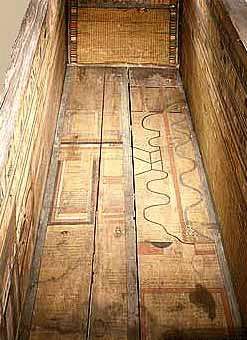In some of the texts, the king boards the sun-boat of Re and passes through different regions in the sky, encountering many gods. In other texts, the king reaches the sky by flying up as a bird, such as a falcon or a goose. At other times the king climbs up the ladder of the sky. What all these texts have in common is an emphasis on the eternal existence of the king and the location of the sky as the realm of the Afterlife, which is dominated by the sun-god Re. The night sky is also described, particularly the imperishable stars.
Generally, the text is supposed to provide services to the deceased king in his ascent into the sky and with his reception in the world of the divine. Every possible means is given for this assistance, including a ladder or ramp leading to the sky, clouds, storms hail, incense and sunlight. The god, Shu, who holds up the sky is there for his assistance, while the text communicates knowledge to the pharaoh of the customs and places in the hereafter. It also warns him of dangers. There are dialogues with gatekeepers and ferryman where the king is given the specific knowledge that he will need in order to name the correct names and answer all the questions needed to prove his legitimacy and make his way though the afterlife.
Many of the locations remain unclear to us, but the Field of Reeds, the Field of Offerings, the Lake of the Jackal and the Winding Waterway are clearly important. The waterways of the heavens are navigated by boat, so the king is dependent on the efforts of his ferryman. Though the afterworld is celestial in nature, it does not seem to be all that desirable of a place to stay. Not even Re is happy here, only seemingly able to bear out the time before sunrise when he could be freed. The king arrives in this realm violently, and then is repeatedly identified with the creator god Atum.
There are many references to various problems such as repelling the attacks of various supernatural beings and we find, for example in spell 244, the “smashing of the red pots” specifically intended to annihilate one’s enemies. But more mundane topics are also approached. On earth, the king had needed a boat to travel throughout Egypt along the Nile; in the next world, he would need a boat as well. Some of the prayers call for food and provisions; some assert that the king will not lose the power of his limbs, that he will still move, breathe, eat, and copulate in the next world.
We find an expressed plea for the king to overcome death by entering the eternal course of the cosmos together with the sun god in his solar barque, but we also find the king with a strong, general association with Osiris. Here, we find the earliest known reference to Osiris as the ruler of the underworld. In spell number 239 this relationship is especially evident, and we find considerable reference to the Osiris legend. Almost all of the myth’s elements may be found within this text. Osiris’ son, Horus, along with Osiris’ two sisters, Isis and Nephthys, search for the murdered god (Osiris). Horus finds his father and revives him. It also provides a version of the contention of Horus and Seth.
A number of specifically ritualistic text stand out, such as the ‘Opening of the Mouth’ ceremony, which to the best of our knowledge is here presented for the first time. There are also offering and statue rituals.

The Coffin Texts – The Book of Two Ways

The Coffin Text, which basically superseded the Pyramid Text as magical funerary spells at the end of the Old Kingdom, are principally a Middle Kingdom phenomenon, though we may begin to find examples as early as the late Old Kingdom. In effect, they democratized the afterlife, eliminating the royal exclusivity of the Pyramid Text.
Mostly, as the modern name of this collection of spells implies, the text was found on Middle Kingdom coffins of officials and their subordinates. However, we may also find the spells inscribed on tomb walls, stelae, canopic chests, papyri and even mummy masks.
Though many are unique to individual coffins, de Buck divided the coffin text into 1,185 spells, with some being assigned to larger compositions such as the Book of the Two Ways. These spells, which always refer to the deceased in the first person singular, attempt to imitate the language of the Old Kingdom, though they are actually produced in the classical language of Middle Egypt. They are inscribed using hieroglyphs, or occasionally early hieratic. Unlike the Pyramid text, they are almost always titled, though at times the title may come at the end of the text.
Usually written in vertical columns, the columns are sometimes split in order to save space. Red ink is utilized for emphasis and as divisions between the spells. However, some important spells are completely written using a red pigment.
For the first time in funerary literature, the coffin text use graphic depictions, though very infrequently. In both the Book of the Two Ways and in spell 464 known as the Field of Offerings, we find detailed plans. At other times (spells 81 and 100) there are textual descriptions of figures that were meant to strengthen the magical results of the text.
Yet the ancient Egyptians were cautious of graphic depictions. One holdover from the Pyramid Texts that we find at least in the early Coffin Text is the mutilation of most of the hieroglyphic signs representing animate objects. Sometimes the glyphs are actually carved as two separate pieces divided by a blank space. At other times, snakes, other animals and various other creatures are inscribed with knives in their backs. This was all intended to ensure that the intact figure would not be able to somehow threaten the deceased person interred nearby.